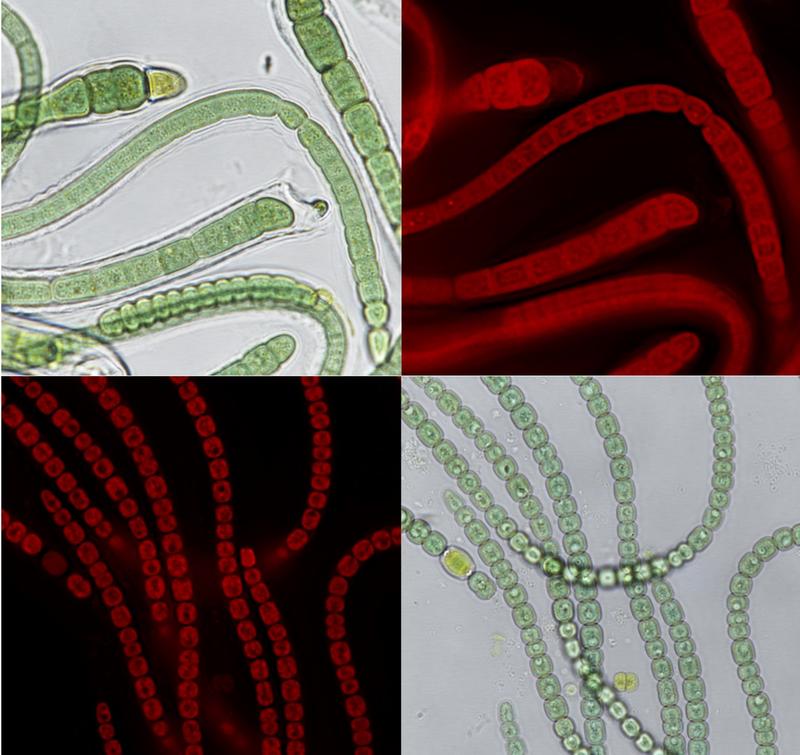

Light microscope images of the cyanobacteria Calothrix desertica DSM 106972 (top) und Anabaena variabilis DSM 107003 (bottom)
Jörn Petersen & Christian Boedeker, DSMZ
In their quest to find new model systems in cyanobacteria, Associate Professor Dr. Jörn Petersen and Junior Research Group leader Dr. Meina Neumann-Schaal of the Leibniz Institute DSMZ-German Collection of Microorganisms and Cell Cultures compared the genome and metabolic profiles of six non-marine cyanobacteria.
Their research revealed striking differences in the metabolic repertoire of these organisms und corroborated an entirely unexpected inter-species transfer of primary metabolism genes. Now, the scientists from Brunswick in northern Germany had their findings published in the renowned journal ‘Genome Biology and Evolution’.
After conducting an extensive comparison of the genome and metabolism of five different cyanobacteria (with Synechocystis sp. PCC 6803 acting as reference strain), the researchers found not only substantial differences regarding the metabolic profiles of these different photosynthetic bacteria, but also demonstrated that the bacteria individually adapt to day-night-cycles.
There were large discrepancies between the investigated strains with respect to the assimilation of the greenhouse gas CO2 and its storage in form of carbohydrates. The decrypted genomes form the basis of the understanding of such metabolic variety.
For instance, one strain isolated in the Chilean Atacama Desert 60 years ago and ever since practically held in “solitary confinement”, the aptly named Calothrix desertica DSM 106972, contains three times as many genes as the reference organism. The results reveal the urgent necessity to utilise the biodiversity of cultivated cyanobacteria above and beyond the established model systems to allow the full exploitation of their hidden biotechnological potential.
Portrait cyanobacteria
Cyanobacteria are one of the oldest life forms on earth. For a long time, their appearance led scientists to mistakenly rank them among algae (“blue-green algae”). But four decades ago, evidence emerged that these organisms represent their own phylum within the world of bacteria. They are one of the most important primary producers of the planet’s oceans and practically invented plant photosynthesis more than three billion years ago.
These days they play an important role in biotechnology, including in the production of peptides, amino acids, vitamins and pigments. In the public eye, they mostly make an appearance when producing compounds toxic to humans and animals as a consequence of “algal bloom” in warm summers. Last year, the Leibniz Institute DSMZ-German Collection of Microorganisms and Cell Cultures expanded its collection by incorporating the organism-groups cyanobacteria and protists. Apart from their conservation and supply, the DSMZ in Brunswick also conducts extensive research on these microorganisms.
Original publication
Will, E.S. et al. (2018) Day and Night: Metabolic Profiles and Evolutionary Relationships of Six Axenic Non-Marine Cyanobacteria. Genome Biol. Evol. 11(1):270-294
DSMZ press contact:
Sven-David Müller, Head of Public Relations, Leibniz Institute DSMZ-German Collection of Microorganisms and Cell Cultures GmbH
Phone: ++49 (0)531 / 2616-300
Mail: sven.david.mueller@dsmz.de
About the Leibniz Institute DSMZ
The Leibniz Institute DSMZ-German Collection of Microorganisms and Cell Cultures is the world's most diverse collection of biological resources (bacteria, archaea, protists, yeasts, fungi, bacteriophages, plant viruses, genomic bacterial DNA as well as human and animal cell lines). Microorganisms and cell cultures are collected, investigated and archived at the DSMZ. As an institution of the Leibniz Association, the DSMZ with its extensive scientific services and biological resources has been a global partner for research, science and industry since 1969. The DSMZ is the first registered collection in Europe (Regulation (EU) No. 511/2014) and certified according to the quality standard ISO 9001:2015. As a patent depository, it offers the only possibility in Germany to deposit biological material in accordance with the requirements of the Budapest Treaty. In addition to scientific services, research is the second pillar of the DSMZ. The institute, located on the Science Campus Braunschweig-Süd, accommodates more than 66,500 cultures and biomaterials and has 198 employees. www.dsmz.de
The Leibniz Association
The Leibniz Association connects 95 independent research institutions that range in focus from the natural, engineering and environmental sciences via economics, spatial and social sciences to the humanities. Leibniz Institutes address issues of social, economic and ecological relevance. They conduct knowledge-driven and applied basic research, maintain scientific infrastructure and provide research-based services. The Leibniz Association identifies focus areas for knowledge transfer to policy-makers, academia, business and the public. Leibniz institutions collaborate intensively with universities – in the form of “Leibniz ScienceCampi” (thematic partnerships between university and non-university research institutes), for example – as well as with industry and other partners at home and abroad. They are subject to an independent evaluation procedure that is unparalleled in its transparency. Due to the importance of the institutions for the country as a whole, they are funded jointly by the Federation and the Länder, employing some 19,100 individuals, including 9,900 researchers. The entire budget of all the institutes is approximately 1.9 billion Euros.
Will, E.S. et al. (2018) Day and Night: Metabolic Profiles and Evolutionary Relationships of Six Axenic Non-Marine Cyanobacteria. Genome Biol. Evol. 11(1):270-294












